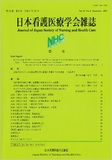Japanese
English
- 有料閲覧
- Abstract 文献概要
- 参考文献 Reference
Aim: This study aimed to investigate the interdialytic weight gain (IWG) and to examine the thirst distress, thirst intensity, and coping behaviors of patients receiving hemodialysis treatment in Japan.
Methods: The design of this study was a cross-sectional study that used a questionnaire survey. The study was conducted with 173 patients receiving hemodialysis treatment at dialysis centers in Kyoto, Japan. The survey items included IWG, the Thirst Distress Scale, thirst intensity, and coping behaviors for thirst.
Results: Thirty-eight patients were classified into the well-managed group (WMG) and 135 patients into the unwell-managed group (UMG), based on the upper limit for IWG by excess. There were no significant differences in the thirst distress between the WMG and the UMG. No significant difference was found in the variation of thirst intensity between intraday and interday in the WMG; however, significant differences were observed in the variation of thirst intensity between both intraday and interday in UMG. Significant biases were found “gargle” and “lick candy” to be the coping behaviors for thirst between the WMG and the UMG.
Conclusions: The number of UMG patients was about 3.5 times as much as that of the WMG patients in this study. In the UMG, intraday thirst was remarkable before going to bed at night, and interday thirst was remarkable on the two non-dialysis days.
Aim: This study aimed to investigate the interdialytic weight gain (IWG) and to examine the thirst distress, thirst intensity, and coping behaviors of patients receiving hemodialysis treatment in Japan.
Methods: The design of this study was a cross-sectional study that used a questionnaire survey. The study was conducted with 173 patients receiving hemodialysis treatment at dialysis centers in Kyoto, Japan. The survey items included IWG, the Thirst Distress Scale, thirst intensity, and coping behaviors for thirst.
Results: Thirty-eight patients were classified into the well-managed group (WMG) and 135 patients into the unwell-managed group (UMG), based on the upper limit for IWG by excess. There were no significant differences in the thirst distress between the WMG and the UMG. No significant difference was found in the variation of thirst intensity between intraday and interday in the WMG; however, significant differences were observed in the variation of thirst intensity between both intraday and interday in UMG. Significant biases were found “gargle” and “lick candy” to be the coping behaviors for thirst between the WMG and the UMG.
Conclusions: The number of UMG patients was about 3.5 times as much as that of the WMG patients in this study. In the UMG, intraday thirst was remarkable before going to bed at night, and interday thirst was remarkable on the two non-dialysis days.
Copyright © 2021, Japan Society of Nursing and Health Care All rights reserved.


